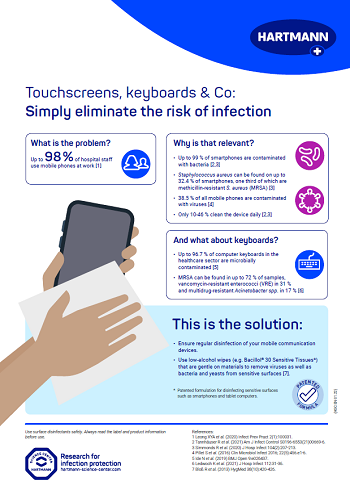HARTMANN SCIENCE CENTER

Mobile communication devices are increasingly used in various areas of healthcare delivery. Smartphones, near-patient hi-tech monitors or tablet computers used for patient files may improve the efficiency of nursing activities. However, latest scientific studies show that the digitalisation of the clinical environment involves the risk of pathogen transmission.
If devices are touched in the proximity of patients, pathogens may be transmitted. 98 % [1] of healthcare providers use a mobile phone during workup to 99 % of them are contaminated with bacteria. Staphylococcus areus was found in 32.4 % - one third of them being methicillin-resistant S. aureus (MRSA). Contaminations with viruses were found in 38.5 % of the analysed smartphones [2] [3].
Not only smartphones, but also keyboards show microbial contamination: in the healthcare sector, this is up to 96.7 % of the examined computer keyboards [4]. In a study from 2021 [5], keyboards from several hospitals were examined for microbial contamination. Here, MRSA could be detected in 72 % of the samples. Vancomycin-resistant enterococci (VRE) and multi-resistant Acinetobacter spp. were present in 31 % and 17 % of the samples.
Decontamination measures can prevent the transmission of nosocomial pathogens. Experts recommend making disinfection of mobile communication devices standard practice – a conclusion that has not yet become accepted among users. Although smartphones, for instance, are used intensively in the clinical setting, only 10-46 % [2] [3] clean their device regularly. One barrier to compliance is the worry that disinfectants may damage the sensitive surfaces.
Low-alcohol wipes (e.g. Bacillol® 30 Sensitive Tissues) are considered an effective and gentle method for decolonising sensitive surfaces. A study [6], confirms: they are suitable for rapid disinfection of alcohol-sensitive surfaces of mobile electronic devices without causing any damage. Even sensitive medical devices (e.g. stethoscopes) and examination couches can be disinfected gently.

Sources: